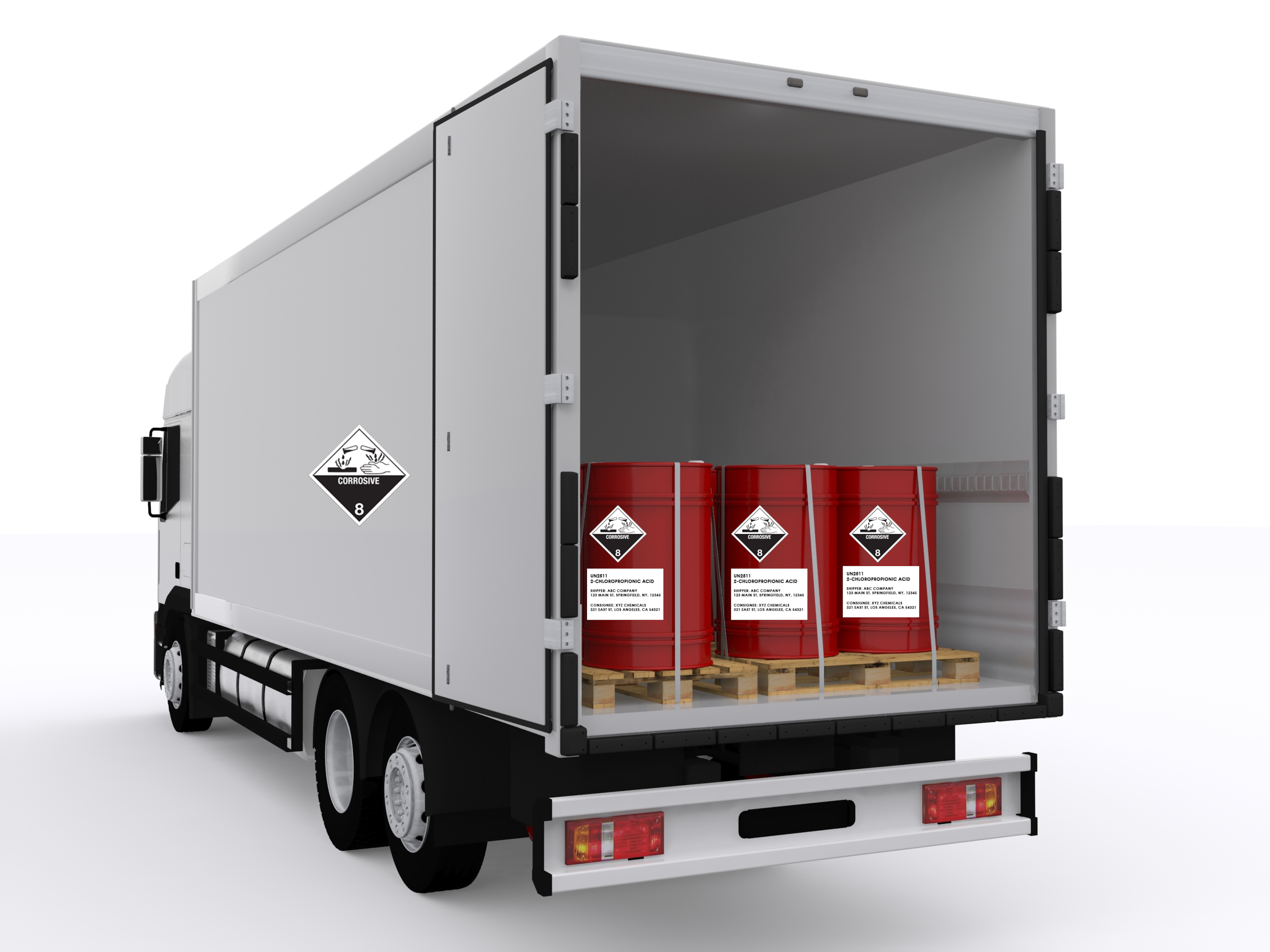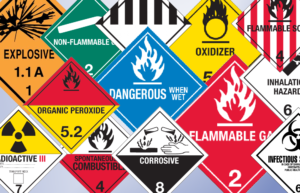Did you know that over 3 billion tons of hazardous materials are transported in the US every year? Every day, hundreds of thousands of hazmat packages with hazmat labels – ranging from explosives to miscellaneous hazardous materials are transported across the length and breadth of the world.
In order to reduce the risks associated with transporting these materials, hazmat personnel are required to take a wide range of safety measures and comply with a number of federal and international regulations at every step of the process. One such step is the marking, labeling, and placarding of hazmat packages to communicate the potential hazards of the material being transported to everyone who is involved in the process.
Why is it so important to mark, label, and placard hazmat packages properly? What are the regulations associated with hazmat labels, marking, and placarding? Let us take a look.
Importance of Hazmat Labels, Marking, and Placarding
There are a number of reasons why hazmat packages need to be marked, labeled, and placarded properly. These include:
Legal Requirements
They are required by federal and international laws. Persons can be fined for failing to mark, label, or placard hazmat packages or for incorrectly marking, labeling, or placarding hazmat packages. It is why hazmat professionals often use the acronym CIPC (Compliance Is a Primary Concern) to establish w well defined requirement such as the marking, labeling and placarding of hazardous materials.
Identification of Hazardous Materials
They allow hazmat personnel and other people involved in the storage and transportation of hazmat, as well as first responders to identify the materials contained in the packages and understand the hazards associated with them.
Handling Instructions
They contain specific instructions regarding how the packages must be handled, assist in determining segregation, and which can greatly reduce the risk of hazmat incidents during transportation.
Safety of General Public
They alert general public and let them know that they are in the vicinity of hazardous materials. While a lay person might not understand what the labels, markings, or placards actually mean, they can certainly understand that hazardous materials are close by and remain cautious.
Emergency Response
In the event of an accident, hazmat markings, labels, and placards will provide emergency responders a sense of what kind of materials are involved in the accident and what kind of hazards they pose. Placards, in particular, can be extremely helpful, since they are large in size and visible, which allows emergency responders to assess the situation from a distance and avoid being unnecessarily or unknowingly exposed to hazardous materials.
Hazmat Marking, Labeling, and Placarding – What Do Federal Regulations Say a Label Must Include?
Title 49 of the Code of Federal Regulations (49 CFR), International Air Transport Association (IATA), International Civil Aviation Organization (ICAO), and the International Maritime Dangerous Goods Code (IMDG) make it mandatory for all hazmat packages transported in commerce to be properly marked, labeled, and placarded – until specified otherwise.
While markings, labels, and placards are all identifiers and serve the same purpose – to communicate the potential risks associated with the hazmat being transported – they are not one and the same.
Hazmat Marking
Markings are used to describe the contents in a hazmat package. They generally include information like:
- The shipping name of the material being transported
- The UN/ID number of the material
- Weight of the package
- Name and address of the shipper
- Name and address of the consignee
- Instructions and warnings (if any)
Markings can be directly printed on a package or affixed to its surface as long as the marking remains legible and undamaged.
Requirements for Hazmat Markings
- It must be visible and legible.
- It must be durable.
- It can be printed on or affixed to the surface of the package – at any place except at the bottom.
- The color of the marking must be in contrast with the color of the surface where it is printed or affixed to, so that it is clearly visible.
- It must be printed or affixed in such a way that it is not obscured by other labels, attachments, and advertisements on the package.
Apart from this, there are many other regulations to be complied with depending on the material being transported. For instance, a package that contains liquid hazardous materials must be marked with what is called an orientation marking, which is usually illustrated by two arrows pointing upward. Similarly, a package that contains materials that are poisonous by inhalation must be marked ‘inhalation hazard”.
The complete list of regulations to be followed regarding hazmat markings can be found here.
Hazmat Labels

Labels are used to indicate the hazard of the material being transported and the potential hazards associated with it. Hazmat labels are generally designed in the shape of a diamond (square on point). The hazmat label, however, might differ from one package to another – depending on the materials being transported, the hazard class/division they belong to, and the mode of transportation. Depending on the material being transported, duplicate labeling might also be required in some cases.
Requirements for Hazmat Labels
- The label must be clearly visible.
- The label must be weather resistant and durable enough to withstand the conditions incident to transportation.
- The label must only be printed on or affixed to the top or the sides of the package – never at the bottom.
- The color of the label must be in contrast to the color of the surface it is printed on or affixed to.
- The label must be shaped like a diamond (square on point) and must meet the specifications regarding size, color, printing, and inner border.
- The label must be printed on or affixed to the surface of the package being transported – adjacent to the marking containing the proper shipping name – except in cases where the dimensions of the package are inadequate.
- If a package contains materials belonging to different hazard classes, it must be affixed with as many labels as required – depending on the types of materials in the package. For instance, if the materials belong to three different hazard classes, the package must display three label.
- An illustrative representation of all types of hazmat labels can be found here.
Hazmat Placarding
Placards – just like hazmat labels and markings – are visible identifiers that are meant to communicate the hazards associated with the materials being transported. The difference is that placards are much larger in size compared to markings and labels and are not meant to be affixed to non-bulk packages. They must be affixed to bulk packages, unit load devices, freight containers, and rail cars that transport these packages. The details of which can be found here.
Under federal regulations, the nine hazard classes are divided into two tables – each of which has different placarding requirements.
The first table includes the following hazard classes.
- Explosives (1.1, 1.2, and 1.3)
- Poison gas (2.3)
- Dangerous when wet (4.3)
- Organic peroxide (Type B, liquid or solid, temperature controlled) (5.2)
- Materials poisonous by inhalation (6.1)
- Radioactive materials (7)
The second table includes the following hazard classes.
- Explosives (1.4, 1.5, and 1.6)
- Flammable gas (2.1)
- Non-flammable gas (2.2)
- Flammable or combustible liquids (3)
- Flammable solids (4.1)
- Spontaneously combustible materials (4.2)
- Oxidizers (5.1)
- Organic peroxide (Other than Type B, liquid or solid, and temperature controlled) (5.2)
- Poisonous materials (except materials that are poisonous by inhalation) (6.1)
- Corrosive substances (8)
- Class 9 materials (9)
Placarding is mandatory for the hazardous materials listed under the first table regardless of the quantity being transported. For the materials listed under the second table, placarding is required only if the aggregate weight of the hazardous materials being transported is 1,001 pounds or greater.
It should be noted that infectious substances (6.2) technically come under the second table. However, there are no placarding requirements for these materials – regardless of the quantity being transported. Apart from this, there are a number of other circumstances where placards might not be required to transport hazardous materials. The full list of hazmat placarding exceptions can be found in § 172.504 in this link.
Hazmat Placarding Requirements
- Bulk packages, unit load devices, freight containers, railcars, and intermodal containers must be placarded on all four sides.
- The hazard class number of the material being transported must be displayed at the bottom corner of each placard.
- Each placard must be diamond shaped and must measure at least 9.84 inches (250 mm) on each side. The text and numbers included in the placard – the hazard class number in particular – must measure at least 1.6 inches (41 mm).
- The placards must be made of durable material and must be able to withstand exposure to open weather.
- The placards must be securely affixed to the packages, containers or transport vehicles.
Hazmat Labels, Marking, and Placarding Training for Hazmat Employees

The task of marking, labeling, and placarding hazmat packages requires a great deal of regulatory knowledge and training. Employees need to undergo 49 CFR, IATA/ICAO, or IMDG training programs (depending on the mode of transportation they are involved in) at regular intervals and make sure they are aware of all the regulations they need to comply with at different stages of the transportation process.
It should be noted that the aforementioned training is mandatory for all employees who are involved in hazmat transportation – not just those who mark, label, and placard hazmat packages. Also, the training program must meet the requirements specified in 49 CFR, IATA/ICAO, and IMDG. It is the duty of the employer to make sure all employees are trained as often as needed.
A comprehensive hazmat training program must contain the following components.
- General awareness training
- Function or job specific training
- Safety training
- Security awareness training
- In-depth security training if applicable
Upon completing the training program, a hazmat employee must be able to do the following:
- Identify and categorize different types of hazard materials depending on the hazard class they belong to.
- Have a clear understanding of the regulations and procedures to be followed while placing or storing hazardous materials that are compatible with each other and while segregating hazardous materials that are incompatible with each other.
- Mark, label, and placard hazmat packages in accordance with federal regulations or verify marked, labeled, and placarded hazmat packages.
- Prepare or verify the documentation needed for hazmat packages.
- Have a clear idea of the safety measures to be taken, the security protocols to be followed, and the information to be provided to emergency responders in the event of a hazmat incident.
How Often Should Employees Undergo Hazmat Training?
All employees must complete hazmat training before they handle hazardous materials or be involved in hazmat storage and transportation in any capacity. Employees are required to complete the initial training within a span of 90 days – starting from the date on which they are hired.
Once the initial training is completed, they must be trained at least once every two years (in case of IATA/ICAO training) or once every three years (in case of 49 CFR or IMDG training).
If a key regulation regarding hazmat transportation is amended, updated, or repealed, or if a new regulation is introduced, employees must complete a hazmat training program that is based on the new or updated regulations. Changes in protocols for hazmat labels in these regulation updates are common.
Similarly, if an employee is promoted or demoted to a different position or if there is a change in their job function due to any other reason, they must undergo the necessary training prior to starting the new job function.
The Most Comprehensive Training Programs for Hazmat Employees
At Hazmat University, we know the need and importance of hazardous materials training better than anyone else. We offer a wide array of online training courses and programs for hazmat employees all over the world.
Developed by knowledgeable hazmat professionals with over four decades of experience in the industry, our programs are based on the latest regulatory requirements.
Our training programs contain a number of interactive exercises and quizzes which can make it easier for you to learn and understand the regulatory requirements associated with your job. We review and update our training materials as necessary per the changes in the regulations to make sure our programs are in compliance with the latest regulatory requirements.
The best part about our training programs is that they are web-based. No matter where you are located, you can complete the training program from the comfort of your home or office and obtain the certification you need.
To find out more about our hazmat training programs, call us today at 609-493-4956 or 844-831-8698 or contact us online.
WE NEVER STOP LEARNING 🍎
Be Confident. Be Competent. Be Compliant. ®

